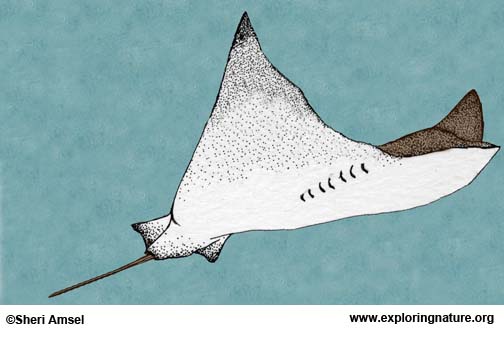

They are found in Florida and the Northern Caribbean waters.
They live in sandy areas and around reefs.
They are dark on top (dorsal surface) and white underneath. They have a long tail and 1-2 stinging spines at the base of the tail. They are roughly shaped like a diamond with wide, flapping wings, up to 5 feet wide, for swimming.
They swim along the sandy bottom looking for prey. They sleep in the sand on the bottom of the water with just their eyes showing. If a person accidentally steps on a sleeping stingray, it will flip up its back end and sting with its tail stingers. They can get used to humans being around them and will accept food from people. Hammerhead sharks will prey on them.
They eat small fish, clams, squid, crabs etc.
Females are pregnant for 4-11 months (gestation). They have about 4 babies per litter called pups.
Kingdom: Animalia
Phylum: Chordata
Subphylum: Vertebrata
Class: Chondrichthyes
Order: Rajiformes
Suborder: Rajoidei
Family: Dasyatidae/Subfamily: Dasyatinae
Genus: Dasyatis
Species: D. americana
When you research information you must cite the reference. Citing for websites is different from citing from books, magazines and periodicals. The style of citing shown here is from the MLA Style Citations (Modern Language Association).
When citing a WEBSITE the general format is as follows.
Author Last Name, First Name(s). "Title: Subtitle of Part of Web Page, if appropriate." Title: Subtitle: Section of Page if appropriate. Sponsoring/Publishing Agency, If Given. Additional significant descriptive information. Date of Electronic Publication or other Date, such as Last Updated. Day Month Year of access < URL >.
Amsel, Sheri. "Stingray (Southern)" Exploring Nature Educational Resource ©2005-2024. December 13, 2024
< http://www.exploringnature.org/db/view/Stingray-Southern >

